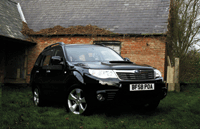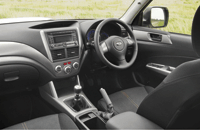Diesel boxer engine in Subaru Forester

Subarus have been a favourite among country folk for years, but the one thing the firm’s customers have yearned for is a diesel version willing to take on the role of a family vehicle. Until now, that is.
Already seen in the Legacy, launched this time last year, the very same diesel boxer engine is now available in the Forester, pretty much rendering the poor old petrol obsolete – unless you own a stake in Shell and have a penchant for filling stations and Ginsters pasties.
And you’ve got to hand it to Subaru. They’ve come up with the world’s first diesel boxer engine and have started to roll it out across the range. There’s an eagily awaited Impreza on the way later this year, too.
Like the company’s unusual symmetrical all-wheel drive, the boxer engine has become a hallmark of the brand. Invented by Karl Benz back in 1896, the boxer engine has graced the likes of the Porsche Cayman, the Ferrari Testarossa and the iconic VW Beetle.
Subaru is not one to do things in a hurry. For more than 40 years, they’ve worked on the horizontally opposed, 180deg cylinder layout so that each piston is positioned horizontally, and designed so each piston movement meets the other in perfect alignment.
Because the crankshaft is in the centre of the engine on exactly the same plane as the pistons and cylinders, it’s able to cope with the increased pressure a diesel engine produces. And, says Subaru, because it uses a shorter and more rigid crankshaft than a petrol engine, power is produced with less vibration and engine noise.
Team this pokey flat four diesel with Subaru’s all-wheel-drive system, and you’ll feel like a boy racer all over again – but with some added tweed and perhaps slightly greyer hair.
When the boxer diesel first featured in the Legacy, it came with five speeds as standard. In the Forester it’s gained another gear and with it, more credibility as a real contender for a top SUV. Not an SUV in a Chelsea tractor sort of way, maybe just in an understated Subaru way.
Throttle response is astonishingly lively in the Forester, harking back to its sporty heritage. But watch your right foot, otherwise those impressive economy figures of 44.8mpg may seem a little out of reach.
The conventional five-speed high/low ratio box which featured on the previous Forester has been replaced with a quick, but extremely tight, six-speed transmission.
And, because 6th is configured slightly higher than 5th, and 1st is lower than in equivalent models, low-end torque is just where you want it, even on dubious terrain.
Offroad, the full-time all-wheel drive system, uses Subaru’s vehicle dynamic control to detect slip and direct the power to the axle with most grip. On farm, this low-end torque is enough to get you up steep inclines with control and confidence more akin to a pick-up than an estate 4×4.

Handling is good, as you would expect in a Subaru, and the Forester seems to handle higher speeds more comfortably than its cousin, the Legacy. Despite being a little lively going into corners, it soon corrects itself without any dramatic wheel movements.
The 145bhp diesel – the petrol is a mere 3hp higher – is expected to attract more than 80 % of future Forester buyers, according to Subaru.
Looks-wise, the new Forester has ditched that large estate bulkiness, instead opting for a more conventional SUV look. Because it uses the new Impreza’s underpinnings, height’s shot up by 110mm, and it’s gained 10mm more ground clearance. But despite this, its centre of gravity is actually lowered thanks to the boxer engine. Chrome detailing and a pronounced bonnet scoop complete the look.
Inside, trimmings are high quality and although a little dated, it’s a nice place to be. It’s available in three specs, the entry level X, the XC and the XSn. We tested the XSn, with satnav, leather seats, huge panoramic roof and push-button start, but it’s the XC that’s expected to be the bestseller at £22,495.
Rear seats and load space are comparable with others in its class, but a lip-less boot entry and flat folding rear seats make it all the more practical for loading.
While the old Subaru Forester struggled with its residuals, the diesel version should enable this vehicle to hold its value for longer.
And, despite the fact that their distinctive six-starred logo will no longer grace the World Rally Championship stage – Subaru pulled out in December last year – the diesel should reaffirm the Subaru in farmers’ eyes as a solid workhorse built to last.
SUBARU FORESTER: KEY FACTS
- Power: 2-litre, four-cylinder Boxer Diesel
- Towing capacity: 2 tonnes
- Top speed: 115.5mph
- Tax/insurance: £170/9E
- Price: 2.0D X (£20,295) 2.0D XC (£22,495) 2.0D XSN (25,495)

